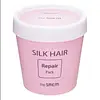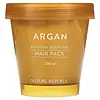What's inside
What's inside
 Key Ingredients
Key Ingredients

 Benefits
Benefits

 Concerns
Concerns

 Ingredients Side-by-side
Ingredients Side-by-side

Water
Skin ConditioningCetyl Alcohol
EmollientStearyl Alcohol
EmollientBehentrimonium Chloride
PreservativeDimethicone
EmollientGlycerin
HumectantC13-16 Isoparaffin
SolventDicaprylyl Ether
EmollientIsopropyl Alcohol
SolventArgania Spinosa Kernel Oil
EmollientOlea Europaea Fruit Oil
MaskingSimmondsia Chinensis Seed Oil
EmollientCaprylic/Capric Triglyceride
MaskingHydrolyzed Soy Protein
HumectantHydrolyzed Sweet Almond Protein
Skin ConditioningSodium PCA
HumectantHydrolyzed Keratin
HumectantPotassium Cocoyl Glutamate
Arginine
MaskingAspartic Acid
MaskingAvena Sativa Protein Extract
Skin ConditioningPCA
HumectantSilk Amino Acids
HumectantHydrolyzed Silk
HumectantGlycine
BufferingAlanine
MaskingCamellia Japonica Seed Oil
EmollientEuterpe Oleracea Fruit Oil
Skin ConditioningGossypium Herbaceum Seed Oil
Skin ConditioningHelianthus Annuus Seed Oil
EmollientHippophae Rhamnoides Oil
EmollientHordeum Distichon Extract
Skin ProtectingMacadamia Ternifolia Seed Oil
EmollientPersea Gratissima Oil
Skin ConditioningPrunus Persica Kernel Oil
EmollientSodium Dilauramidoglutamide Lysine
HumectantVitis Vinifera Seed Oil
EmollientSerine
MaskingValine
MaskingIsoleucine
Skin ConditioningProline
Skin ConditioningThreonine
Cetraria Islandica Extract
CleansingHedera Helix Extract
AntimicrobialVeronica Officinalis Extract
Skin ConditioningHistidine
HumectantPhenylalanine
MaskingEuterpe Oleracea Fruit Extract
Glycine Max Seed Extract
Skin ConditioningJuglans Regia Seed Extract
Skin ConditioningJuniperus Communis Fruit Extract
PerfumingLycium Chinense Fruit Extract
AntioxidantMorus Alba Fruit Extract
AntioxidantOlea Europaea Fruit Extract
BleachingPrunus Avium Seed Extract
Skin ConditioningRubus Fruticosus Fruit Extract
AstringentRubus Idaeus Fruit Extract
AstringentVaccinium Angustifolium Fruit Extract
Skin ProtectingVaccinium Macrocarpon Fruit Extract
AstringentVaccinium Myrtillus Fruit Extract
Skin ConditioningVitis Vinifera Seed Extract
AntimicrobialHydroxyethylcellulose
Emulsion StabilisingButylene Glycol
HumectantCitric Acid
BufferingSodium Lactate
BufferingBenzophenone-5
UV AbsorberDisodium EDTA
Sodium Benzoate
MaskingPotassium Sorbate
Preservative1,2-Hexanediol
Skin ConditioningEthylhexylglycerin
Skin ConditioningCI 15985
Cosmetic ColorantCI 19140
Cosmetic ColorantParfum
MaskingButylphenyl Methylpropional
PerfumingWater, Cetyl Alcohol, Stearyl Alcohol, Behentrimonium Chloride, Dimethicone, Glycerin, C13-16 Isoparaffin, Dicaprylyl Ether, Isopropyl Alcohol, Argania Spinosa Kernel Oil, Olea Europaea Fruit Oil, Simmondsia Chinensis Seed Oil, Caprylic/Capric Triglyceride, Hydrolyzed Soy Protein, Hydrolyzed Sweet Almond Protein, Sodium PCA, Hydrolyzed Keratin, Potassium Cocoyl Glutamate, Arginine, Aspartic Acid, Avena Sativa Protein Extract, PCA, Silk Amino Acids, Hydrolyzed Silk, Glycine, Alanine, Camellia Japonica Seed Oil, Euterpe Oleracea Fruit Oil, Gossypium Herbaceum Seed Oil, Helianthus Annuus Seed Oil, Hippophae Rhamnoides Oil, Hordeum Distichon Extract, Macadamia Ternifolia Seed Oil, Persea Gratissima Oil, Prunus Persica Kernel Oil, Sodium Dilauramidoglutamide Lysine, Vitis Vinifera Seed Oil, Serine, Valine, Isoleucine, Proline, Threonine, Cetraria Islandica Extract, Hedera Helix Extract, Veronica Officinalis Extract, Histidine, Phenylalanine, Euterpe Oleracea Fruit Extract, Glycine Max Seed Extract, Juglans Regia Seed Extract, Juniperus Communis Fruit Extract, Lycium Chinense Fruit Extract, Morus Alba Fruit Extract, Olea Europaea Fruit Extract, Prunus Avium Seed Extract, Rubus Fruticosus Fruit Extract, Rubus Idaeus Fruit Extract, Vaccinium Angustifolium Fruit Extract, Vaccinium Macrocarpon Fruit Extract, Vaccinium Myrtillus Fruit Extract, Vitis Vinifera Seed Extract, Hydroxyethylcellulose, Butylene Glycol, Citric Acid, Sodium Lactate, Benzophenone-5, Disodium EDTA, Sodium Benzoate, Potassium Sorbate, 1,2-Hexanediol, Ethylhexylglycerin, CI 15985, CI 19140, Parfum, Butylphenyl Methylpropional
Water
Skin ConditioningDimethicone
EmollientPropylene Glycol
HumectantCetearyl Alcohol
EmollientStearamidopropyl Dimethylamine
EmulsifyingQuaternium-18
Behentrimonium Chloride
PreservativeIsopropyl Alcohol
SolventHydroxyethylcellulose
Emulsion StabilisingRehmannia Chinensis Root Extract
Skin ConditioningAmodimethicone
Citric Acid
BufferingButylene Glycol
HumectantArgania Spinosa Kernel Oil
EmollientMentha Arvensis Extract
Masking1,2-Hexanediol
Skin ConditioningAcorus Calamus Root Extract
PerfumingBiota Orientalis Leaf Extract
HumectantChrysanthemum Zawadskii Extract
Skin ConditioningGlycyrrhiza Glabra Root Extract
BleachingLycium Chinense Fruit Extract
AntioxidantMorus Alba Bark Extract
Skin ConditioningPanax Ginseng Root Extract
EmollientXanthium Strumarium Fruit Extract
Skin ConditioningEthylhexylglycerin
Skin ConditioningOenothera Biennis Oil
EmollientRosa Canina Fruit Oil
EmollientBiotin
AntiseborrhoeicHydrolyzed Corn Protein
Skin ConditioningHydrolyzed Soy Protein
HumectantHydrolyzed Wheat Protein
Skin ConditioningParfum
MaskingLimonene
PerfumingHydroxycitronellal
PerfumingLinalool
PerfumingWater, Dimethicone, Propylene Glycol, Cetearyl Alcohol, Stearamidopropyl Dimethylamine, Quaternium-18, Behentrimonium Chloride, Isopropyl Alcohol, Hydroxyethylcellulose, Rehmannia Chinensis Root Extract, Amodimethicone, Citric Acid, Butylene Glycol, Argania Spinosa Kernel Oil, Mentha Arvensis Extract, 1,2-Hexanediol, Acorus Calamus Root Extract, Biota Orientalis Leaf Extract, Chrysanthemum Zawadskii Extract, Glycyrrhiza Glabra Root Extract, Lycium Chinense Fruit Extract, Morus Alba Bark Extract, Panax Ginseng Root Extract, Xanthium Strumarium Fruit Extract, Ethylhexylglycerin, Oenothera Biennis Oil, Rosa Canina Fruit Oil, Biotin, Hydrolyzed Corn Protein, Hydrolyzed Soy Protein, Hydrolyzed Wheat Protein, Parfum, Limonene, Hydroxycitronellal, Linalool
Ingredients Explained
These ingredients are found in both products.
Ingredients higher up in an ingredient list are typically present in a larger amount.
1,2-Hexanediol is a synthetic liquid and another multi-functional powerhouse.
It is a:
- Humectant, drawing moisture into the skin
- Emollient, helping to soften skin
- Solvent, dispersing and stabilizing formulas
- Preservative booster, enhancing the antimicrobial activity of other preservatives
You may know this ingredient as argan oil. Argan Oil has antioxidant, hydrating, and soothing properties.
Studies have shown argan oil can help fight again radical damage from the sun. This makes it effective at preventing hyperpigmentation.
Large amounts of vitamin E found in argan oil helps the skin retain water. Argan oil also contains fatty acids such as linoleic acid, oleic acid, and palmitic acid. It is also a good source of lipids.
Another benefit of argan oil is skin-soothing. It can help reduce inflammation-related skin symptoms.
Argan Oil is effective at regulating sebum production in pores. This can make it effective at treating hormonal acne.
Traditionally, argan oil was used for its antibacterial and antifungal properties. However, argan oil contains fatty acids that may make it not fungal-acne safe.
Argan Trees are native to Morocco.
Learn more about Argania Spinosa Kernel OilThis ingredient is a preservative and often used for it's anti-static properties. You'll most likely see this ingredient in hair conditioners.
It does not cause irritation or sensitization in leave-on products at 1-5%.
Butylene Glycol (or BG) is used within cosmetic products for a few different reasons:
Overall, Butylene Glycol is a safe and well-rounded ingredient that works well with other ingredients.
Though this ingredient works well with most skin types, some people with sensitive skin may experience a reaction such as allergic rashes, closed comedones, or itchiness.
Learn more about Butylene GlycolCitric Acid is an alpha hydroxy acid (AHA) naturally found in citrus fruits like oranges, lemons, and limes.
Like other AHAs, citric acid can exfoliate skin by breaking down the bonds that hold dead skin cells together. This helps reveal smoother and brighter skin underneath.
However, this exfoliating effect only happens at high concentrations (20%) which can be hard to find in cosmetic products.
Due to this, citric acid is usually included in small amounts as a pH adjuster. This helps keep products slightly more acidic and compatible with skin's natural pH.
In skincare formulas, citric acid can:
While it can provide some skin benefits, research shows lactic acid and glycolic acid are generally more effective and less irritating exfoliants.
Most citric acid used in skincare today is made by fermenting sugars (usually from molasses). This synthetic version is identical to the natural citrus form but easier to stabilize and use in formulations.
Read more about some other popular AHA's here:
Learn more about Citric AcidDimethicone is a type of synthetic silicone created from natural materials such as quartz.
What it does:
Dimethicone comes in different viscosities:
Depending on the viscosity, dimethicone has different properties.
Ingredients lists don't always show which type is used, so we recommend reaching out to the brand if you have questions about the viscosity.
This ingredient is unlikely to cause irritation because it does not get absorbed into skin. However, people with silicone allergies should be careful about using this ingredient.
Note: Dimethicone may contribute to pilling. This is because it is not oil or water soluble, so pilling may occur when layered with products. When mixed with heavy oils in a formula, the outcome is also quite greasy.
Learn more about DimethiconeEthylhexylglycerin (we can't pronounce this either) is commonly used as a preservative and skin softener. It is derived from glyceryl.
You might see Ethylhexylglycerin often paired with other preservatives such as phenoxyethanol. Ethylhexylglycerin has been found to increase the effectiveness of these other preservatives.
Hydrolyzed Soy Protein is a vegan protein made to mimic hydrolyzed collagen. It is created from soy, or glycine soja.
This ingredient is a humectant, meaning it helps hydrate the skin by binding to water. According to a manufacturer, it is also a great hair conditioner.
Read more about hydrolyzed collagen here.
Learn more about Hydrolyzed Soy ProteinHydroxyethylcellulose is used to improve the texture of products. It is created from a chemical reaction involving ethylene oxide and alkali-cellulose. Cellulose is a sugar found in plant cell walls and help give plants structure.
This ingredient helps stabilize products by preventing ingredients from separating. It can also help thicken the texture of a product.
This ingredient can also be found in pill medicines to help our bodies digest other ingredients.
Learn more about HydroxyethylcelluloseIsopropyl Alcohol is more commonly known as rubbing alcohol. It is most commonly used as a solvent, meaning it helps other ingredients dissolve.
This ingredient is an astringent alcohol. Astringent alcohols may also irritate skin as they high amounts may strip away your skin's natural oils.
Other types of astringent alcohols include:
According to the National Rosacea Society based in the US, you should be mindful of products with these alcohols in the top half of ingredients.
Any type of sanitizing product will have high amounts of alcohol to help kill bacteria and viruses.
Learn more about Isopropyl AlcoholLycium Chinense Fruit Extract comes from a type of goji berry plant.
Goji berries contain polysaccharides, carotenoids and flavonoids. These give it antioxidant properties that protect your skin from free-radical molecules.
Polysaccharides help hydrate the top layer of skin due to its ability to mimic natural carbohydrates.
Learn more about Lycium Chinense Fruit ExtractParfum is a catch-all term for an ingredient or more that is used to give a scent to products.
Also called "fragrance", this ingredient can be a blend of hundreds of chemicals or plant oils. This means every product with "fragrance" or "parfum" in the ingredients list is a different mixture.
For instance, Habanolide is a proprietary trade name for a specific aroma chemical. When used as a fragrance ingredient in cosmetics, most aroma chemicals fall under the broad labeling category of “FRAGRANCE” or “PARFUM” according to EU and US regulations.
The term 'parfum' or 'fragrance' is not regulated in many countries. In many cases, it is up to the brand to define this term.
For instance, many brands choose to label themselves as "fragrance-free" because they are not using synthetic fragrances. However, their products may still contain ingredients such as essential oils that are considered a fragrance by INCI standards.
One example is Calendula flower extract. Calendula is an essential oil that still imparts a scent or 'fragrance'.
Depending on the blend, the ingredients in the mixture can cause allergies and sensitivities on the skin. Some ingredients that are known EU allergens include linalool and citronellol.
Parfum can also be used to mask or cover an unpleasant scent.
The bottom line is: not all fragrances/parfum/ingredients are created equally. If you are worried about fragrances, we recommend taking a closer look at an ingredient. And of course, we always recommend speaking with a professional.
Learn more about ParfumWater. It's the most common cosmetic ingredient of all. You'll usually see it at the top of ingredient lists, meaning that it makes up the largest part of the product.
So why is it so popular? Water most often acts as a solvent - this means that it helps dissolve other ingredients into the formulation.
You'll also recognize water as that liquid we all need to stay alive. If you see this, drink a glass of water. Stay hydrated!
Learn more about Water